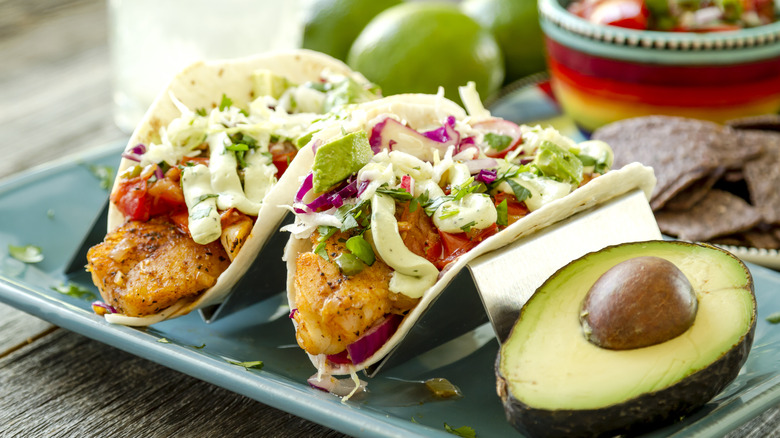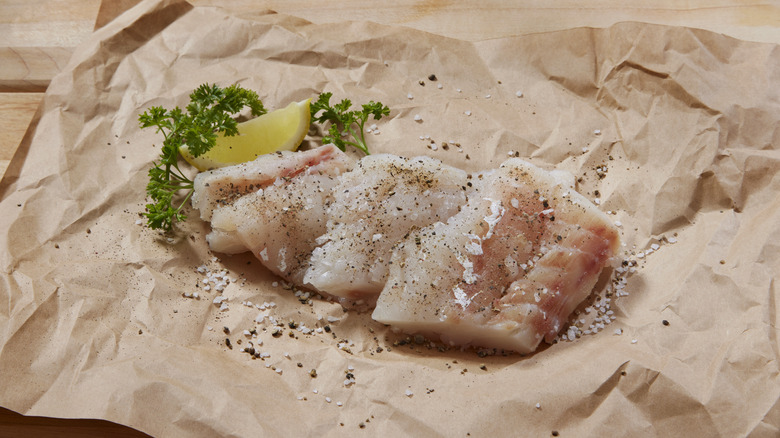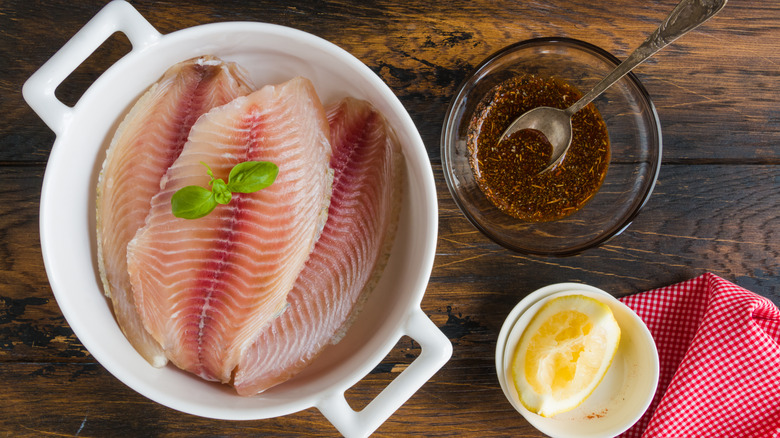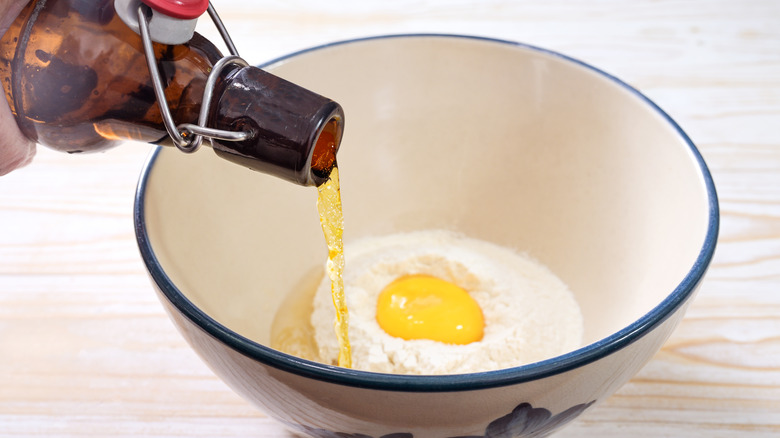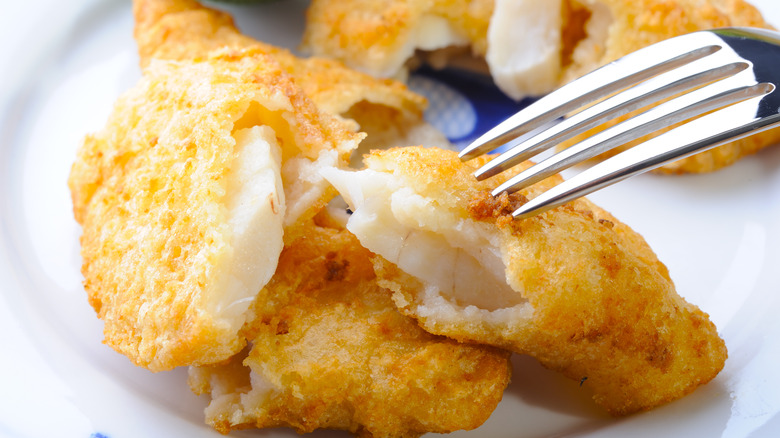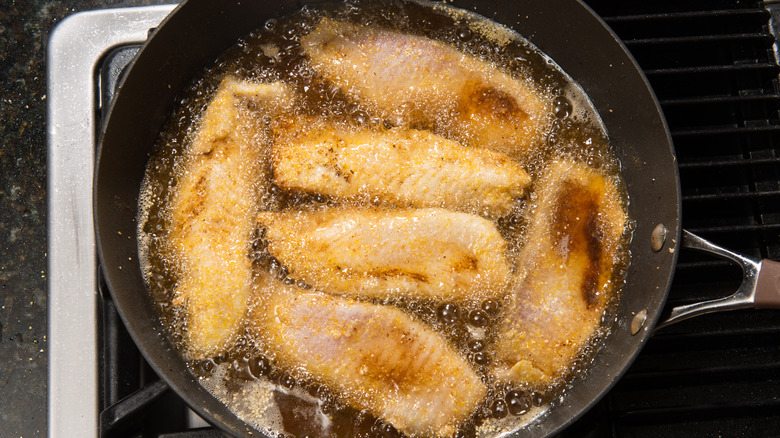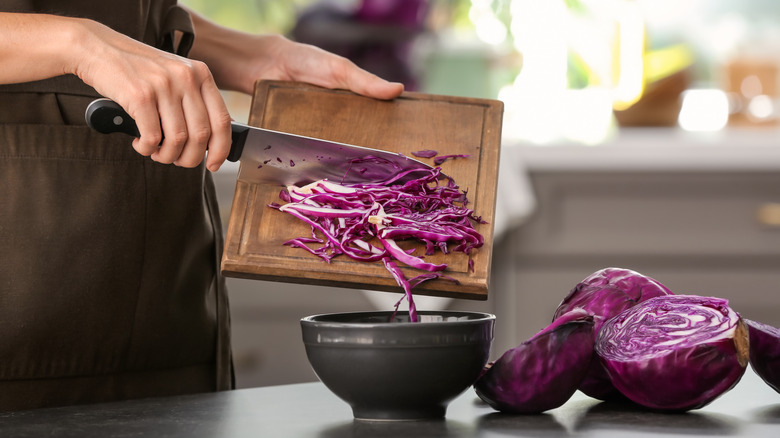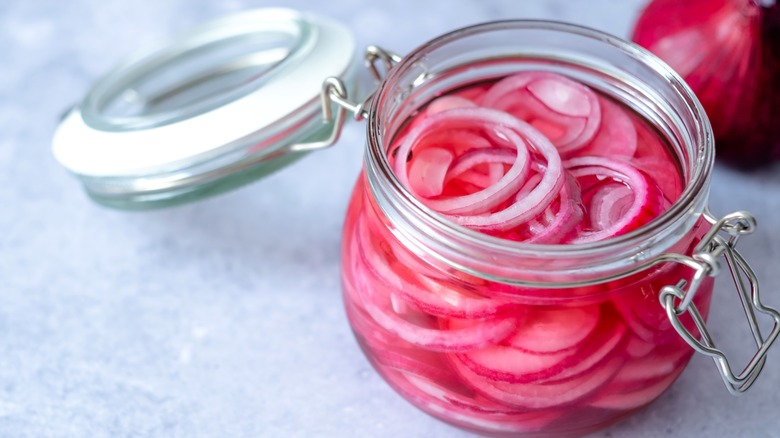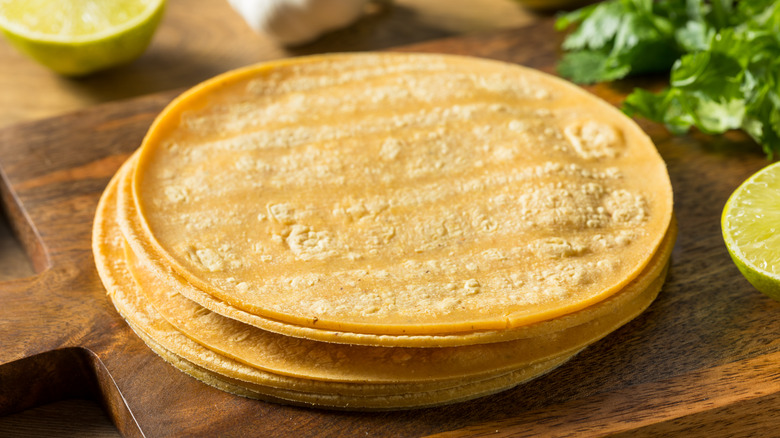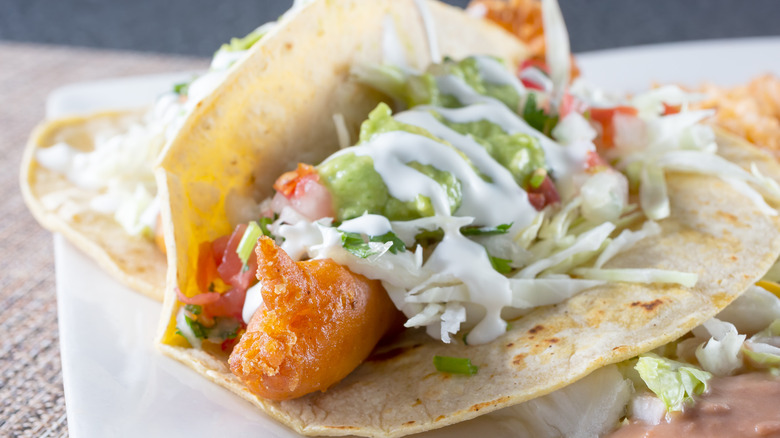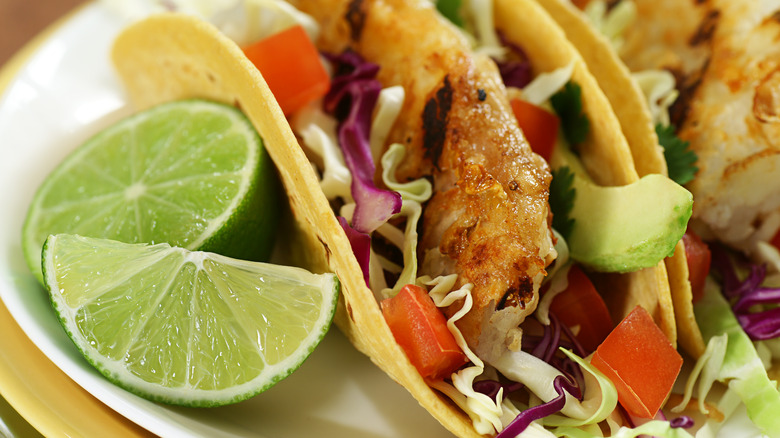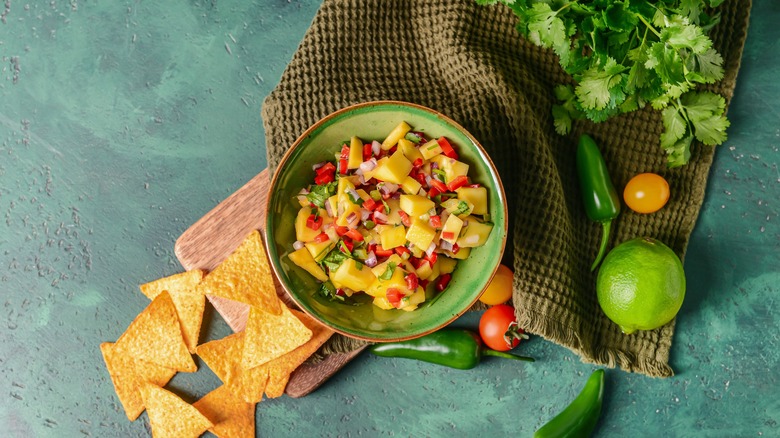11 Mistakes Everyone Makes With Fish Tacos
Originally from Baja California, the fish taco has become one of America's favorites. Baja's tasty little secret is not a secret anymore, and you can now find fish tacos all over — from taco trucks to sit-down places, delicious fish tacos can be found on the menu.
Traditional Baja fish tacos are made with fried pieces of white fish and served on a tortilla with coleslaw, creamy sauce, and all the fixings. These tasty tacos are the perfect reason to hit the road and head south. But if a little trip south of the border to get your fish taco fix isn't in the cards, you can make them yourself; luckily, you don't have to be a fisherman or an expert home chef to make delicious fish tacos in your own kitchen.
When making fish tacos, you can either go the traditional route, or break all the rules to make your own signature style. Before you bust out the frying pan though, you should know the common mistakes everyone makes with fish tacos, so you can learn how to make mouthwatering fish tacos that will be a guaranteed hit each and every time.
1. Mistake: Using the wrong fish
To make great fish tacos, you need to start with great fish, and fresh is best. When buying fish, look for one that has clear eyes and doesn't smell too fishy — both signs that it's past its best. If buying fillets, ask your local fishmonger questions to ensure freshness.
The best type of fish for fish tacos is a firm white fish like cod, tilapia, haddock, red snapper, flounder, mahi mahi, or rockfish. These will hold their shape and withstand the battering and frying process without falling apart. Tuna, monkfish, and swordfish are not ideal for fish tacos, mainly because of their taste and texture. While salmon isn't as common for fish tacos, it has the right texture and consistency for fish tacos as long as it's grilled or baked instead of battered and fried because oily fish like salmon will get too mushy.
Fish tacos aren't just made with fish; shrimp, lobster, and even octopus make tasty tacos. Local freshwater fish like catfish, walleye, and kokanee are also excellent choices, and because they are local, they are sure to be fresh.
2. Mistake: Not marinating the fish
Marinating the fish for a few hours before cooking infuses it with flavor. White fish has a mild taste and will absorb the seasonings of a marinade and punch it up with flavor. Celebrity chef Guy Fieri uses a marinade of tequila, cumin, and lime in his fish tacos (via Food Network). But lime isn't the only citrus for marinade — lemon, orange, and mandarin all work well too. Just be careful not to overdo it. Award-winning cookbook author Joanne Weir tells The Denver Post that one common mistake people make with seafood is overseasoning it. As a general rule, marinades should be three parts fat, one part acid, and one part seasoning. You can play around with the variables from that basic formula to find the best marinade for your homemade fish tacos.
If you're worried about your fish tacos being too fishy for your tastes, try dousing the fish in milk to remove its smell. Casein, a protein in milk, neutralizes the odor-causing issue, and a quick soak is all it takes to remove the offending scent. Make sure to rinse the fish before adding it to the marinade.
3. Mistake: Skipping the beer batter
Traditional fish tacos are battered and fried, making them crunchy on the outside and flaky on the inside. And to get that perfect outer crunch, the fish fillets need more than a dredge in flour — they need a beer batter. A simple beer batter is just flour, beer, and some seasonings. The mixture comes together into the thick batter that holds the fish together, creating the perfect crunchy texture. For an even crispier outside, replace some of the all-purpose wheat flour with rice flour.
The type of beer you use will affect the overall finished dish too. For a lighter taste, stick with lagers and pilsners, and for a deeper, robust flavor, use a darker beer like an amber. Be careful not to go too dark because a stout or porter can overpower the tacos. If you're concerned about the alcohol content in beer, you can use a non-alcoholic beer or even soda water.
4. Mistake: Over or undercooking the fish
There is no denying that fish can be tricky to cook. If it's undercooked, it can have a mushy texture and potentially lead to foodborne illness. Overcooking, on the other hand, ruins the light, flaky texture. The only surefire way to know the fish isn't undercooked is to check the temperature. The CDC recommends that fish be cooked to an internal temperature of 145 degrees Fahrenheit. When the thermometer reads a few degrees below 145 degrees, it's safe to remove the fish as it will continue to cook internally, raising the temperature to the safe zone.
If you don't have a thermometer, there are other ways to check if the fish is fully cooked. You can poke the fish with the flat end of a wooden skewer, and if there's any resistance, then it's not ready. The skewer will easily slide into a properly cooked piece of fish. You can also check the color. Fully cooked white fish and seafood will have an opaque white color, almost off-white, while salmon will be light pink.
5. Mistake: Getting fish stuck to the pan
In restaurants, professional cooks and chefs use a deep fryer to perfectly fry fish for fish tacos. Most home chefs don't have the same equipment, and using a pan on the stove is often the best option. But beware of sticky fish. Sometimes, frying goes wrong, and when you go to flip your fish, it sticks to the pan and breaks, causing your perfect fillets to become a mashed-up mess.
There are three tricks to keeping the fish from sticking. The first is to make sure to use plenty of frying oil. If you're trying to replicate the deep fryer, use a pan with high sides. A Dutch oven or cast iron pan are great options because they hold the heat well and keep the oil hot for frying. The next important step is to preheat the pan. Putting cold or room-temperature fish into a hot pan will help keep it from sticking. And lastly, resist the urge to flip the fish too soon. Have patience and let it fry on one side until golden, then flip to cook the other side. Ideally, you should only flip the fish pieces once.
6. Mistake: Cutting the cabbage too thick
Cabbage salad, cabbage salsa, coleslaw, or whatever you call it in your region, is a must for fish tacos. Some like to make it creamy with mayo, others like it tangy with a vinegar base, but no matter how you like your coleslaw, the trick to making it good is to slice it thin. Large pieces of cabbage are too chewy and can overtake the delicate balance of flavor and texture in fish tacos. As for the variety of cabbage, whether you choose red or green cabbage is just a matter of preference. Red cabbage has a more robust flavor, while green is more mild. But both are equally good in fish tacos.
The best way to get thinly sliced cabbage is to use a mandoline. This will help cut the cabbage into uniform slices. Make sure to follow the instructions and use safety gloves because mandolines can be dangerous, and you certainly don't want to cut your fingers. If you don't have a mandoline, a sharp knife can do the trick.
7. Mistake: Omitting the pickled red onions
In Baja, traditional fish tacos are always served with pickled red onions. They are easy to make, and when you do make them, be sure to make a big batch because they are great on fish tacos, sandwiches, burritos, salad, and just about anything that tastes better with some tangy touches.
There are a few different ways to make pickled onions. You can do a quick pickle using a mix of vinegar, water, and honey. This only takes around thirty minutes, and the briny pickles will still have a bit of a crunch. Or you can do an overnight pickle, which is similar, but gives the red onions twelve hours to pickle, making them softer and tangier. Lacto-fermented red onions get their brine from salt and spices. These have a longer fermentation time, and the wait is worth it because they not only have great flavor, but the lacto-fermentation makes them a healthy option; adding more lacto-fermented foods to your diet has many health benefits.
8. Mistake: Opting for flour tortillas
Flour tortillas are excellent for burritos and quesadillas, but are not the best for fish tacos. With the batter-fried fish, flour tortillas will make the fish tacos too heavy, and the tortillas will be overloaded. Corn tortillas are the best choice for fish tacos, but some people avoid using them at home because they can fall apart. There is a simple trick to using corn tortillas, though — they need to be heated up first. You don't need to add oil; just heat them in a dry comal or saute pan and flip them several times. This should be the last step in your fish taco process, so the tortillas are freshly heated. Use a cloth to store the hot ones while you finish heating a stack, then serve.
Florida chef Bernie Matz, speaking with Insider, recommends skipping the shelf-stable corn tortillas for homemade or buying refrigerated or frozen ones, explaining, "they simply taste better and have better texture." Check your local international market or farmers' market to see if anyone in your area makes fresh corn tortillas or sells frozen homemade tortillas. If you like the smoky flavor of charred tortillas, you can get that at home by laying the corn tortillas directly on the burner using tongs to flip them so they char evenly. Just keep an eye on them because they can burn fast.
9. Mistake: Not using authentic Mexican crema
Restaurants serve fish tacos with a creamy sauce that's a perfect match for the salty fried pieces of fish. But when you try to make it at home, that creamy sauce never seems to turn out quite right. That's because it's not sour cream. It's actually Mexican crema, which may be similar to sour cream but with a few key differences. Mexican crema is thin and runny, while traditional sour cream is dense, with a sharper flavor.
The consistency of Mexican crema makes it easy to drizzle over your tacos. It tastes great by itself, or you can give it a little kick by adding a touch or two or hot sauce like Tapatio, Cholula, or Tabasco. The color will turn pinkish orange and resemble fry sauce, but the flavor will be something entirely its own.
You don't have to travel south of the border to find Mexican crema; it's available in most supermarkets and international shops. It also tastes great on other classic Mexican fare, like enchiladas, burritos, and nachos.
10. Mistake: Serving without lime wedges
In Mexico, limes are king. They are widely available, inexpensive, and give the perfect burst of acidity. Fresh lime is squeezed on carne asada, pozole, barbacoa, and seafood to intensify the taste. Chef Aarón Sánchez explains to Insider that acid is an important flavor component because it compliments rich flavors and provides a nice balance, saying, "Top your tacos with something fresh with citrus or acid as it combats the often heavy and rich fillings." Fish tacos especially benefit from the bright bursts of lime on those salty pieces of fish, so don't make the mistake of serving your fish tacos without lime wedges.
Luckily, limes are available year-round. To find the best limes, look for round, plump limes with smooth skin. Smooth skin means they're fresh and juicy, while wrinkled or dotted skin is a sign of limes that are pithy and drier than they should be. When you pick them up, ripe limes should feel slightly heavy, which means they're full of juice. Color can also indicate ripeness and yellowish or pale green limes are ripe, while bright green ones are not quite ready for a squeeze.
11. Mistake: Skipping the sides
If you want to make your fish tacos stand out, then make sure to serve them with all the tasty sides. Traditional fish tacos in Baja are served with a slew of fresh, tasty garnishes to enhance the overall fish taco experience.
Classic taco sides like salsa and guacamole are a must for fish tacos. Just don't make the mistake of using store-bought salsa and guacamole. They are both easy to make at home and the results will be a thousand times better. Homemade fresh chunky pico de gallo is the best salsa for fish tacos. But bright, fruity salsas, like mango salsa, are also a good choice. Sliced radishes and cucumbers, soaked in lime and sprinkled with salt, are popular in Baja taquerias. Using small, flavorful chilies drowned in vinegar will add a bit of heat and tang, slices of grilled pineapple add some sweetness, and jicama sticks dusted in salt and cumin will add some crunch.
